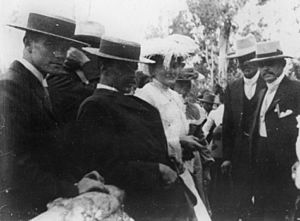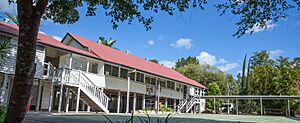Yandina, Queensland facts for kids
Quick facts for kids YandinaSunshine Coast, Queensland |
|||||||||||||||
|---|---|---|---|---|---|---|---|---|---|---|---|---|---|---|---|

Display at the Ginger Factory, 2003
|
|||||||||||||||
| Established | 1870 | ||||||||||||||
| Postcode(s) | 4561 | ||||||||||||||
| Area | 15.4 km2 (5.9 sq mi) | ||||||||||||||
| Time zone | AEST (UTC+10:00) | ||||||||||||||
| Location |
|
||||||||||||||
| LGA(s) | Sunshine Coast Region | ||||||||||||||
| State electorate(s) |
|
||||||||||||||
| Federal Division(s) | Fairfax | ||||||||||||||
|
|||||||||||||||
Yandina is a small town in Queensland, Australia. It is located in the Sunshine Coast Region. In 2021, about 3,073 people lived here. Yandina is known as the Sunshine Coast's oldest continuously settled town.
Contents
Exploring Yandina's Location
Yandina is found in the Sunshine Coast hinterland. This means it is inland, away from the coast. The town's name comes from the Kabi language. "Yan dhinang" means "to cross water by foot." This name points to the first place people could cross the Maroochy River on foot.
How to Get to Yandina
The Bruce Highway passes by Yandina to the east. This big highway helps people travel north and south. Other roads like Yandina-Coolum Road and Yandina-Bli Bli Road go east.
The North Coast railway line also runs through Yandina. The Yandina railway station is right in the town. This train line connects Yandina to other places.
Yandina's Past: A Journey Through Time
Aboriginal people have lived in the Yandina area for over 40,000 years. They were part of the Gubbi Gubbi language group. Different tribes lived in specific areas. For example, the Undandi tribe lived east of the railway line. The Nalbo area was west of the line. Signs like bora rings, pathways, and scarred trees show their long history here.
European Settlement and Early Buildings
European settlers started arriving in the 1850s. The town of Yandina was officially planned in 1870. It was the very first town in the Maroochy district. Many old buildings and the historic look of Stevens Street are still preserved today.
The Anglican church, built in 1880, is the oldest church on the Sunshine Coast. The Yandina hotel was built in 1889. It was moved in 1891 when the railway came through. A team of bullocks and rollers helped move the building. In the same year, the post office moved to the new railway station.
The Koongalba homestead is a private home on the National Heritage List. It is one of several historic homes in Yandina. Yandina was first meant to be the main town of the area. However, the local sugar mill was built in Nambour. This led many workers to move closer to Nambour instead.
Churches and Community Life
The Yandina Baptist Church opened in 1921. Before this, Baptists used the Anglican church for their services. They bought a church building from Pomona and moved it to Yandina. The new church opened on March 16, 1921.
Yandina Presbyterian Church opened on November 30, 1940. These churches have been important parts of the community for many years.
Schools and Industries
Yandina Provisional School opened on November 14, 1889. It became Yandina State School in 1902. A preschool was added in 1974.
Early settlers worked in the timber industry. They cut down trees like beech and cedar. This industry was important until the 1970s. Then, a lack of timber caused the local mill to close. The rich land around Yandina has also been used for farming. People raised beef and dairy cattle. They also grew fruits, sugar cane, and ginger.
Sports and Tourism
The Nambour & District Reds soccer club started in 1974. In 1997, they joined with Yandina Eagles. This created the Nambour Yandina United team.
The Buderim Ginger Factory opened in Yandina in April 1980. It is a popular place for tourists to visit. You can learn about ginger and see how it's made. The Bruce Highway was rerouted around the town in July 1997. Yandina Baptist Church celebrated 100 years in 2021.
Yandina's Population Over Time
The number of people living in Yandina has changed over the years:
- In 2011, there were 2,221 people.
- In 2016, the population grew to 2,371 people.
- By 2021, Yandina had 3,073 residents.
Historic Places to See
Yandina has a special place listed for its history:
- Koongalba, located at 12 Wharf Street. This is a historic house.
Learning in Yandina
Yandina State School is a government primary school. It teaches students from Prep to Year 6. Boys and girls attend this school at 48 School Road. In 2018, about 289 students were enrolled. The school also has a program for special education.
There is no high school in Yandina itself. The closest government high school is Nambour State College. It is located in Nambour, to the south of Yandina.
Important Services in Yandina
Yandina has several important services for the community:
- Maroochy River Fire Station is at 11 Branyandah Street.
- Yandina Ambulance Station is at 2 Machinery Road.
- There is a sewage treatment plant at 10 Focus Lane.
- Yandina Cemetery is at 33 Cordwell Road.
Community Hubs and Activities
The Sunshine Coast Regional Council offers a mobile library service. It visits Stevens Street, bringing books to the community.
The Yandina branch of the Queensland Country Women's Association meets at the Yandina Hall. This hall is located at 11 Stevens Street.
The Yandina RSL Hall is at 24 North Street. This hall is used for community events.
Wonga Park is a sports ground at 8 North Street. It is the home field for Nambour Yandina United. This is a local association football (soccer) club.
Places of Worship
Yandina has several churches:
- All Saints' Anglican Church is at 3 Farrell Street.
- Yandina Baptist Church is at 31 Low Street, on the corner of Railway Street.
- Yandina Seventh-Day Adventist Church is at 23 North Street.
Fun Things to Do in Yandina
Yandina is a charming town with a subtropical feel. It is surrounded by farms and beautiful hinterland. It is known as a "Ginger Town" because of its ginger farms. The Ginger Factory is a top spot for visitors. You can take tours and learn about ginger products.
Popular Attractions
Yandina is home to the famous Buderim Ginger Factory. You can also visit Nutworks here.
The Yandina Historic House is a local history museum. It also serves as a visitor information centre. It is located at 3 Pioneer Road. The Yandina & District Historical Society runs this museum.
Getting Around Yandina
Yandina is located just off exit 215 of the Bruce Highway. The Yandina Station is on the Nambour and Gympie North Line. You can catch passenger trains to Brisbane from here. Bus route 631 also serves Yandina. It connects to Noosa Junction and Nambour.





